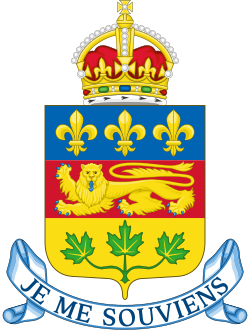
The following outline is provided as an overview of and topical guide to Quebec:
Contents
- General reference
- Geography of Quebec
- Location
- Environment of Quebec
- Heritage sites in Quebec
- Regions of Quebec
- Demography of Quebec
- Government and politics of Quebec
- Branches of the government of Quebec
- International relations of Quebec
- Law and order in Quebec
- Military of Quebec
- Local government in Quebec
- History of Quebec
- History of Quebec, by period
- History of Quebec, by region
- History of Quebec, by subject
- Culture of Quebec
- Art in Quebec
- People of Quebec
- Religion in Quebec
- Sports in Quebec
- Symbols of Quebec
- Economy and infrastructure of Quebec
- Education in Quebec
- See also
- References
- External links
Quebec , a province in the eastern part of Canada, lies between Hudson Bay and the Gulf of St. Lawrence. It is the only Canadian province with a predominantly French-speaking population and the only one whose sole official language is French at the provincial level. Sovereignty plays a large role in the politics of Quebec, and the official opposition social-democratic Parti Québécois advocates national sovereignty for the province and secession from Canada. Sovereigntist governments held referendums on independence in 1980 and in 1995; voters rejected both proposals — the latter by a very narrow margin. In 2006 the House of Commons of Canada passed a symbolic motion recognizing the "Québécois as a nation within a united Canada." [1] [2]




